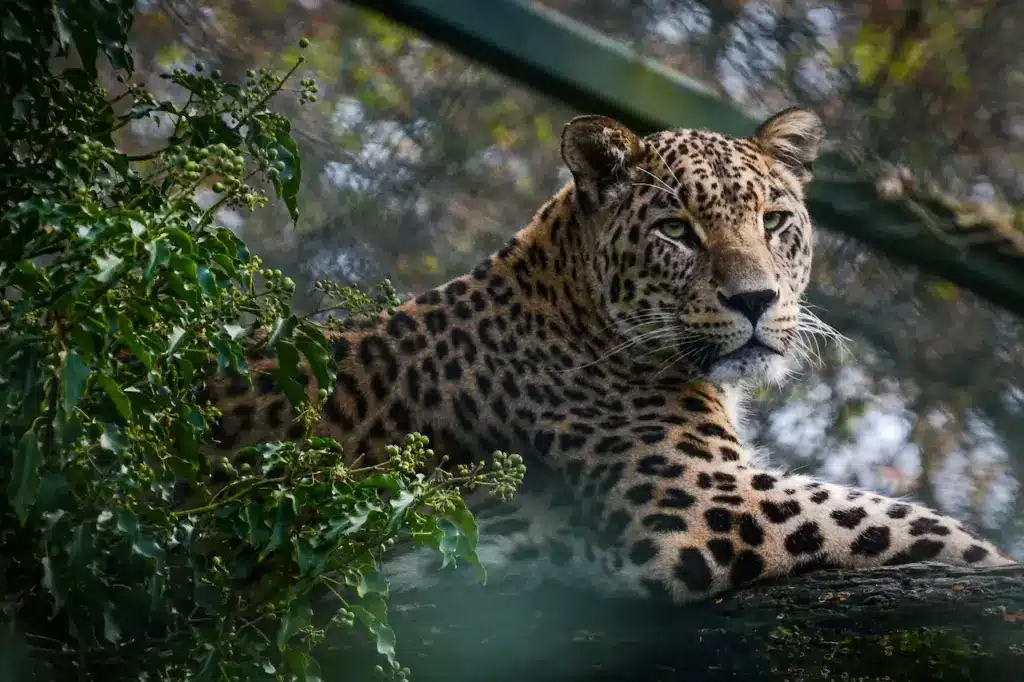Rain Forest Tigers, Leopards, Jaguars And Lions
Amazon Rain Forest
In the Amazon and other rain forests of the New World the jaguar is the top predator. In some South and Central American countries the popular name for this big cat is “tiger,” though it actually looks a lot more like a leopard. Differences between jaguars and leopards include size: The jaguar is a huskier, more powerful animal, with a larger head and a thicker chest and legs. In addition, the spots on a jaguar’s hide are much more complex than those on a leopard. A big jaguar can grow to 8 feet long, nose to tail-tip, and can reach a weight of 250 pounds. It devours just about everything it can catch in the rainforest, from tapirs (the biggest rain forest animal and a distant relative of the rhino) to turtles, which it eats after crunching through the shell with its powerful jaws. Other common prey animals include deer and monkeys. This versatile predator is a good climber and an excellent swimmer. In fact, it will sometimes take on the jungle’s formidable water-dwelling predators—anacondas and caimans—in order to get a meal.
[ez-toc]

South America
The cougar, also known as the puma or mountain lion, has a broader range than any big cat on the planet except the leopard. It can be found from the Canadian Rockies to Patagonia, and is very much at home in South and Central American rain forests, where it preys on the same animals as the jaguar. The cougar is a good climber and a powerful predator, weighing up to around 200 pounds. However, a cougar is no match for a jaguar, and it tends to stay out of the bigger cat’s way.
In spite of what you may have heard, the lion is not the king of the jungle. There are two reasons for this: 1) Lions don’t live in jungles (rainforests); they prefer more open habitats; and, 2) Even if lions did live in rain forests, tigers—which do live in jungles—are larger and stronger. Not that the two species would stand a chance of meeting even then, since tigers live only in Asia, and lions are almost exclusively an African animal . . . .
In any case, tigers are the largest and most formidable big cat on the planet, with adult male Bengal tigers (Pantherea tigris tigris) reaching sizes as large as 227 kilos (500 pounds). The tiger is a widely distributed animal, with a range stretching from the frigid forests of Eastern Siberia to the swampy rain forests of Indonesia. Subspecies that live exclusively in the tropics include the aforementioned Bengal tiger, which lives in India and Bangladesh; the Indo-Chinese tiger (Panthera tigris corbetti) whose range includes Southeast Asia; the Malayan tiger (Panthera tigris jacksoni) and Indonesia’s Sumatran tiger (Panthera tigris sumatrae). One Indonesian rainforest tiger subspecies, the Bali tiger, is now extinct, and another, the Javan tiger, is presumed to have gone extinct during the 1980’s.
In all, only about 4,000 tigers currently exist in the wild anywhere in the world; all subspecies of tiger are critically endangered. Watch a short video of two top predators—one’s a tiger—locked in mortal combat.
Africa
Lions, as we’ve mentioned before, do not live in rain forests. So, in Africa at least, the king of the jungle by default is the leopard. Still, the leopard is no lightweight. They can grow as large as 140 pounds (65 kilos) and have been known to do battle with adult male gorillas—though they’d probably prefer not to. They prey on all sorts of rain forest animals from monkeys to antelopes to rodents, and they often hang their kill in a tree to protect it from other predators and scavengers.
The leopard is the most widespread of the world’s big cats, with a huge range that extends from Siberia in eastern Russia south to Indonesia, and west to nearly the entire continent of Africa. The leopard is an extremely adaptable animal, and often takes up residence near the outskirts of African cities. In Asian rainforests, one thing the leopard must adapt to is the presence of the tiger. Fearless around other creatures, Asian leopards give tigers a wide berth.



